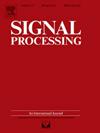时变频谱环境下MIMO雷达低相关旁瓣频谱兼容波形设计
IF 3.4
2区 工程技术
Q2 ENGINEERING, ELECTRICAL & ELECTRONIC
引用次数: 0
摘要
现代雷达工作在具有强烈时变干扰的频谱环境中,这对雷达的性能影响很大。为了解决这一问题,我们采用脉冲组分集脉冲编码内波形,并提出了平均自相关集成旁瓣电平(AISL)来衡量在相干处理间隔内的综合自相关性能。在此基础上,建立了AISL和交叉积分副瓣电平的加权目标函数。此外,利用谱约束和恒模约束来表述优化问题。为了解决这一np困难问题,我们基于乘数框架的交替方向法将原问题转化为几个易于解决的子问题。然后用共轭梯度法求解子问题。我们还提供针对不同雷达性能要求量身定制的加权值选择方法。仿真实验表明,该算法能够在不同条件下准确选择合适的加权值。此外,该算法在副瓣性能和执行效率方面都优于现有算法。本文章由计算机程序翻译,如有差异,请以英文原文为准。
Spectrally compatible waveform design with low correlation sidelobe for MIMO radar under time-varying spectral environment
Modern radar operates in a spectral environment with intense and time-varying interference, which significantly affects the radar performance. To address this problem, we adopt the pulse group diversity pulse intra-coding waveform and propose the average autocorrelation integrated sidelobe level (AISL) to measure the comprehensive autocorrelation performance within a coherent processing interval. Furthermore, the weighted objective function of AISL and cross-integrated sidelobe level is established. Additionally, the spectral and constant modulus constraints are utilized to formulate the optimization problem. To solve this NP-hard problem, we transform the original problem into several easy-to-solve sub-problems based on the alternating direction method of multipliers framework. Then we use the conjugate gradient method to solve the sub-problems. We also provide a weighted value selection approach tailored to different radar performance requirements. Simulation experiments are provided to demonstrate that the proposed algorithm can accurately select appropriate weighted values under diverse conditions. Moreover, the proposed algorithm outperforms the existing algorithms in terms of sidelobe performance and execution efficiency.
求助全文
通过发布文献求助,成功后即可免费获取论文全文。
去求助
来源期刊

Signal Processing
工程技术-工程:电子与电气
CiteScore
9.20
自引率
9.10%
发文量
309
审稿时长
41 days
期刊介绍:
Signal Processing incorporates all aspects of the theory and practice of signal processing. It features original research work, tutorial and review articles, and accounts of practical developments. It is intended for a rapid dissemination of knowledge and experience to engineers and scientists working in the research, development or practical application of signal processing.
Subject areas covered by the journal include: Signal Theory; Stochastic Processes; Detection and Estimation; Spectral Analysis; Filtering; Signal Processing Systems; Software Developments; Image Processing; Pattern Recognition; Optical Signal Processing; Digital Signal Processing; Multi-dimensional Signal Processing; Communication Signal Processing; Biomedical Signal Processing; Geophysical and Astrophysical Signal Processing; Earth Resources Signal Processing; Acoustic and Vibration Signal Processing; Data Processing; Remote Sensing; Signal Processing Technology; Radar Signal Processing; Sonar Signal Processing; Industrial Applications; New Applications.
 求助内容:
求助内容: 应助结果提醒方式:
应助结果提醒方式:


